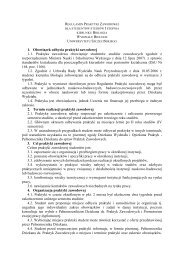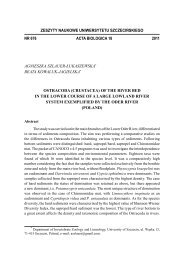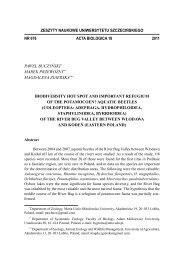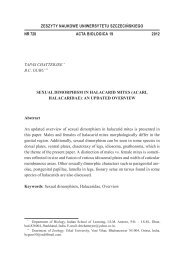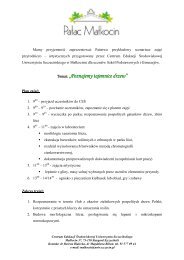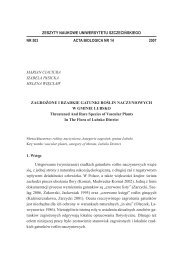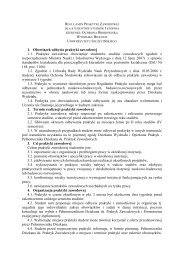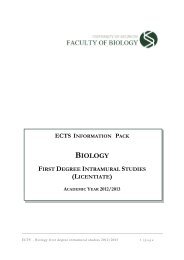7 The water mite fauna (Hydrachnidia) from three springs in ...
7 The water mite fauna (Hydrachnidia) from three springs in ...
7 The water mite fauna (Hydrachnidia) from three springs in ...
You also want an ePaper? Increase the reach of your titles
YUMPU automatically turns print PDFs into web optimized ePapers that Google loves.
120 Andrzej Zawal, Stojmir Stojanovski, K<strong>in</strong>ga Dzierzgowska<br />
It focuses on the characteristics of <strong>water</strong> <strong>mite</strong>s encountered <strong>in</strong> <strong>three</strong> Macedonian<br />
<strong>spr<strong>in</strong>gs</strong> which has never been previously <strong>in</strong>vestigated with regard to <strong>water</strong> <strong>mite</strong>s.<br />
However there are some other dates <strong>from</strong> the <strong>spr<strong>in</strong>gs</strong> (Kunz 2006, Subaquatic<br />
Spr<strong>in</strong>gs 2005–2008) <strong>The</strong> study has lead to a discovery of two new species for the<br />
Balkan Pen<strong>in</strong>sula, namely Lebertia longiseta and Hygrobates setosus, and one<br />
new species for Macedonia, namely Lebertia longiseta.<br />
Material and methods<br />
<strong>The</strong> <strong>in</strong>vestigation of <strong>water</strong> <strong>mite</strong>s <strong>from</strong> <strong>spr<strong>in</strong>gs</strong> <strong>in</strong> Macedonia was carried out<br />
on 20–22 February and 19–30 June 2009. In shallow places (< 1 m) <strong>water</strong> <strong>mite</strong>s<br />
were caught us<strong>in</strong>g a hydro-biological sampler with a triangular hoop, with the<br />
length of the side equall<strong>in</strong>g 20 cm. Each time 20 sweeps were performed, each<br />
cover<strong>in</strong>g about 1 m, which allowed the area of ca. 0.2 m 2 <strong>in</strong> total to be covered.<br />
Water <strong>mite</strong>s were identify by keys: Viets (1936), Sokolov (1940), Wa<strong>in</strong>sta<strong>in</strong><br />
(1980), Zawal (2008) and Di Sabat<strong>in</strong>o et. al. (2010).<br />
Five spr<strong>in</strong>g system areas was <strong>in</strong>vestigated, but <strong>in</strong> two of them there was<br />
no <strong>water</strong> <strong>mite</strong>s. <strong>The</strong> material was collected <strong>in</strong> <strong>three</strong> spr<strong>in</strong>g systems compris<strong>in</strong>g:<br />
1) <strong>spr<strong>in</strong>gs</strong> <strong>in</strong> St. Naum; 2) Biljan<strong>in</strong>i <strong>spr<strong>in</strong>gs</strong> near the Hydrobiological Institute<br />
<strong>in</strong> Ohrid; 3) “Podgoricko Ezero”. In the first of systems 12 samples were collected<br />
<strong>in</strong> 7 localities (5 <strong>in</strong> February and 7 <strong>in</strong> June), but <strong>water</strong> <strong>mite</strong>s were encountered<br />
only <strong>in</strong> 5 localities. In the second system 3 samples <strong>in</strong> 3 localities (1 <strong>in</strong> February<br />
and 2 <strong>in</strong> June) were collected. In the third system 8 samples <strong>in</strong> 8 localities<br />
(<strong>in</strong> June), were collected but <strong>water</strong> <strong>mite</strong>s were present only <strong>in</strong> 5 samples.<br />
<strong>The</strong> collected material conta<strong>in</strong>ed adult specimens as well as larvae (Table<br />
1). While analys<strong>in</strong>g the abundance and frequency of occurrence, only adult<br />
stages were taken <strong>in</strong>to account, s<strong>in</strong>ce the larvae were encountered <strong>in</strong> clusters and<br />
each egg cluster was probably laid by an <strong>in</strong>dividual female. Tak<strong>in</strong>g the larvae <strong>in</strong>to<br />
account would artificially <strong>in</strong>crease the abundance of some species.






